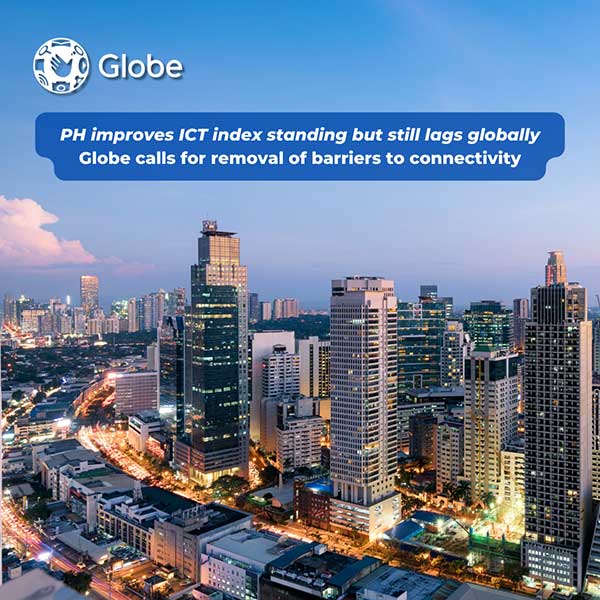
Globe welcomes the Philippines’ advancement in the latest ICT Development Index of the International Telecommunication Union (ITU) as it calls for greater collaboration to remove barriers to connectivity.
This, as the Philippines continues to rate below the global average, lagging behind its neighbors in Southeast Asia.
The 2024 edition of the index released by the ITU, a specialized agency of the UN, scored the Philippines 74.4, an improvement by 14% from last year. But this score is still below the global average of 74.8 and way behind Southeast Asian neighbors such as Singapore, which scored 97.8, Malaysia with 95.0, and Thailand at 91.0.
The Philippines’ score places it among the lowest five in the region, better only than Cambodia (72.6), Laos (65.3), Myanmar (63.8), and Timor-Leste (39.2).
“We are optimistic that we can score even higher in the global ICT Development Index. This should serve as an impetus for all stakeholders including industry players and the government to work more closely to address persistent gaps in our connectivity infrastructure,” said Ernest Cu, Globe President and CEO.
“The private sector has poured several billions in resources for ICT development. We cannot do it alone. There are barriers that can only be addressed through strong collaboration among the industry, government, and other stakeholders,” said Cu.
Greater ICT investment
Cu reiterated that the country needs more substantial investments in digital infrastructure. The private sector has invested a combined PHP 640 billion in just three years, from 2021 to 2023, to upgrade the quality of the country’s connectivity infrastructure.
Globe alone has invested Php 265 billion in capital expenditure and Php 236 billion in operational expenses in the past three years to enhance its network capabilities.
In contrast, the Department of Information and Communications Technology invested only Php 7.6 billion for internet infrastructure from 2018 to 2024.
The Private Sector Advisory Council, a Malacañang-initiated body that brings together industry players, has called on the government to allocate at least Php 240 billion to improve internet infrastructure and work with the private sector to build 35,000 new cell sites across the country.
The Connectivity Plan Task Force (CPTF), led by Cu under the PSAC, is also working with the DICT for the rollout of connectivity infrastructure in Geographically Isolated and Disadvantaged Areas (GIDAs). Globe’s network currently reaches over 500 GIDAs.
Policy reform
Globe also reiterated its call for policy reform to allow connectivity to flourish.
These include the provision of space for telco infrastructure in housing developments and the removal of lease fees for telco infrastructure in buildings and developments through amendments to the outdated National Building Code (1977). Bills seeking this reform are still pending in Congress.
“Telcos should not be charged for installing infrastructure inside buildings and developments that will provide connectivity, which is now a basic necessity like power and water. It is a life enabler, supporting commerce, people’s livelihood, education and leisure needs,” said Cu.
Globe also hopes for the full implementation of Executive Order No. 32, issued in 2023 to streamline the permitting process for telco infrastructure. Globe notes how certain local government units still find ways to circumvent the order, making the approval of permits difficult and slow for telcos.
Broadband access
Amid policy gaps that hinder connectivity, Globe continues to find ways to make broadband connection more affordable to Filipinos.
Last year, Globe launched GFiber Prepaid, which seeks to democratize connectivity by offering fiber-strong broadband connection for as low as Php 33/day. Rolled out in line with Globe’s drive for digital inclusion, GFiber Prepaid offers flexible and reloadable UNLI internet access with no lock ups and monthly bills.
Globe also looks forward to the implementation of the government’s National Broadband Plan, which aims to provide free WiFi connectivity across the country. This project involves the development of a neutral fiber backbone to provide connectivity for government agencies and government-led last mile projects.






















